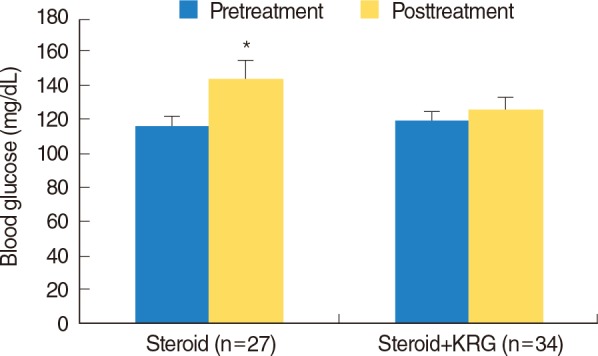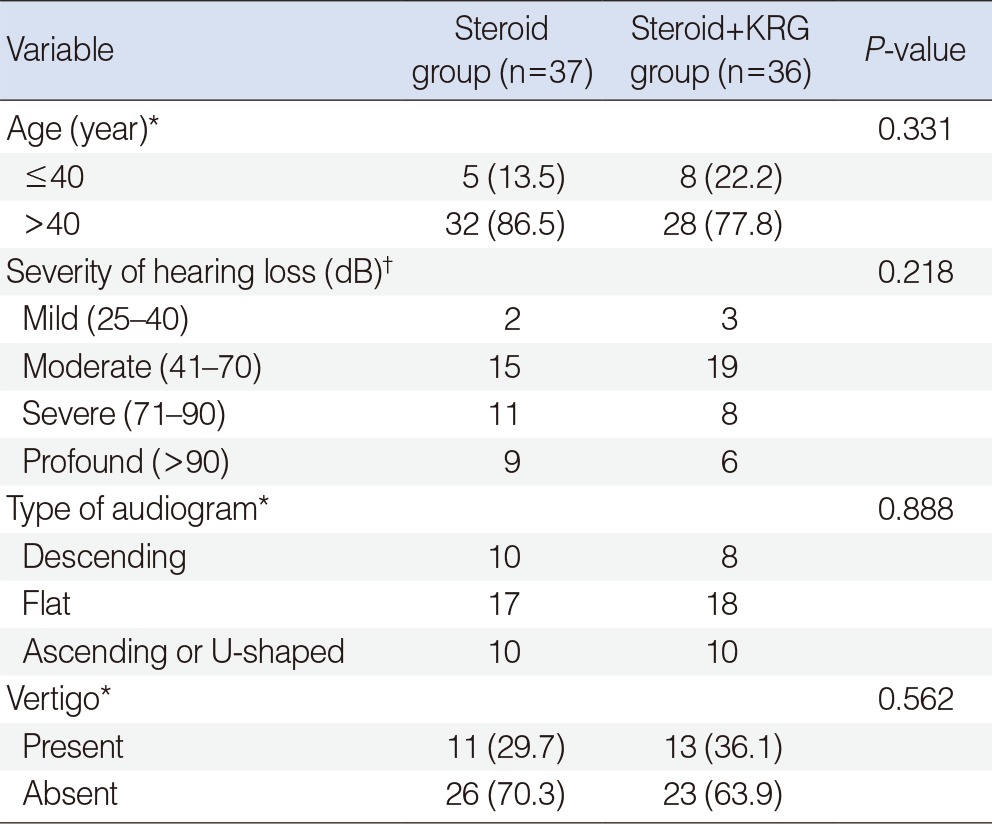1. Im GJ, Chang JW, Choi J, Chae SW, Ko EJ, Jung HH. Protective effect of Korean red ginseng extract on cisplatin ototoxicity in HEI-OC1 auditory cells. Phytother Res. 2010; 4. 24(4):614–621. PMID:
20020438.

2. Choung YH, Kim SW, Tian C, Min JY, Lee HK, Park SN, et al. Korean red ginseng prevents gentamicin-induced hearing loss in rats. Laryngoscope. 2011; 6. 121(6):1294–1302. PMID:
21541943.

3. Tian C, Kim YH, Kim YC, Park KT, Kim SW, Kim YJ, et al. Korean red ginseng ameliorates acute 3-nitropropionic acid-induced cochlear damage in mice. Neurotoxicology. 2013; 1. 34:42–50. PMID:
23164932.

4. Fujita K, Hakuba N, Hata R, Morizane I, Yoshida T, Shudou M, et al. Ginsenoside Rb1 protects against damage to the spiral ganglion cells after cochlear ischemia. Neurosci Lett. 2007; 3. 415(2):113–117. PMID:
17296266.

5. Yu JY, Jin YR, Lee JJ, Chung JH, Noh JY, You SH, et al. Antiplatelet and antithrombotic activities of Korean Red Ginseng. Arch Pharm Res. 2006; 10. 29(10):898–903. PMID:
17121186.

6. Yun YP, Do JH, Ko SR, Ryu SY, Kim JH, Song HC, et al. Effects of Korean red ginseng and its mixed prescription on the high molecular weight dextran-induced blood stasis in rats and human platelet aggregation. J Ethnopharmacol. 2001; 10. 77(2-3):259–264. PMID:
11535373.

7. Barthel A, Scherbaum WA, Bornstein SR. Novel aspects in the mechanisms of steroid diabetes and the regulation of hepatic glucose production by insulin and steroids. Med Klin (Munich). 2003; 4. 98(5):283–286. PMID:
12721674.
8. Kim HY, Kim K. Regulation of signaling molecules associated with insulin action, insulin secretion and pancreatic β-cell mass in the hypoglycemic effects of Korean red ginseng in Goto-Kakizaki rats. J Ethnopharmacol. 2012; 6. 142(1):53–58. PMID:
22543177.

9. De Souza LR, Jenkins AL, Sievenpiper JL, Jovanovski E, Rahelic D, Vuksan V. Korean red ginseng (Panax ginseng C.A. Meyer) root fractions: differential effects on postprandial glycemia in healthy individuals. J Ethnopharmacol. 2011; 9. 137(1):245–250. PMID:
21619921.

10. Hong YJ, Kim N, Lee K, Sonn CH, Lee JE, Kim ST, et al. Korean red ginseng (Panax ginseng) ameliorates type 1 diabetes and restores immune cell compartments. J Ethnopharmacol. 2012; 11. 144(2):225–233. PMID:
22925946.

11. Kim S, Shin BC, Lee MS, Lee H, Ernst E. Red ginseng for type 2 diabetes mellitus: a systematic review of randomized controlled trials. Chin J Integr Med. 2011; 12. 17(12):937–944. PMID:
22139546.

12. Rohrmeier C, Koemm N, Babilas P, Prahs P, Strutz J, Buettner R. Sudden sensorineural hearing loss: systemic steroid therapy and the risk of glucocorticoid-induced hyperglycemia. Eur Arch Otorhinolaryngol. 2013; 3. 270(4):1255–1261. PMID:
22843065.
13. Siegel LG. The treatment of idiopathic sudden sensorineural hearing loss. Otolaryngol Clin North Am. 1975; 6. 8(2):467–473. PMID:
1153209.

14. Cheon SY, Cho KJ, Lee JE, Kim HW, Lee SK, Kim HJ, et al. Cerebroprotective effects of red ginseng extract pretreatment against ischemia-induced oxidative stress and apoptosis. Int J Neurosci. 2013; 4. 123(4):269–277. PMID:
23240589.

15. Ban JY, Kang SW, Lee JS, Chung JH, Ko YG, Choi HS. Korean red ginseng protects against neuronal damage induced by transient focal ischemia in rats. Exp Ther Med. 2012; 4. 3(4):693–698. PMID:
22969953.

16. Lee JS, Choi HS, Kang SW, Chung JH, Park HK, Ban JY, et al. Therapeutic effect of Korean red ginseng on inflammatory cytokines in rats with focal cerebral ischemia/reperfusion injury. Am J Chin Med. 2011; 39(1):83–94. PMID:
21213400.

17. Baldwin D, Apel J. Management of hyperglycemia in hospitalized patients with renal insufficiency or steroid-induced diabetes. Curr Diab Rep. 2013; 2. 13(1):114–120. PMID:
23090580.

18. Gonzalez-Gonzalez JG, Mireles-Zavala LG, Rodriguez-Gutierrez R, Gomez-Almaguer D, Lavalle-Gonzalez FJ, Tamez-Perez HE, et al. Hyperglycemia related to high-dose glucocorticoid use in noncritically ill patients. Diabetol Metab Syndr. 2013; 4. 5(1):18. PMID:
23557386.







 PDF
PDF Citation
Citation Print
Print





 XML Download
XML Download